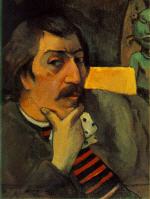
Paul Gauguin was a French postimpressionist painter whose lush color, flat two-dimensional forms, and subject matter helped form the basis of modern art.
Gauguin was born in Paris on June 7, 1848, into a liberal middle-class family. After an adventurous early life, including a four-year stay in Peru with his family and a stint in the French merchant marine, he became a successful Parisian stockbroker, settling into a comfortable bourgeois existence with his wife and five children.
In 1874, after meeting the artist Camille Pissarro and viewing the first impressionist exhibition, he became a collector and amateur painter. He exhibited with the impressionists in 1876, 1880, 1881, 1882, and 1886. In 1883 he gave up his secure existence to devote himself to painting; his wife and children, without adequate subsistence, were forced to return to her family. From 1886 to 1891 Gauguin lived mainly in rural Brittany (except for a trip to Panama and Martinique from 1887 to 1888), where he was the center of a small group of experimental painters known as the school of Pont-Aven. Under the influence of the painter Émile Bernard, Gauguin turned away from impressionism and adapted a less naturalistic style, which he called synthetism.
He found his inspiration in the art of indigenous peoples, in medieval stained glass, and in Japanese prints; he was introduced to Japanese prints by the Dutch artist
Vincent Van Gogh when they spent two months together in Arles, in the south of France, in 1888. Gauguin's new style was characterized by the use of large flat areas of nonnaturalistic color, as in Yellow Christ (1889, Albright-Knox Gallery, Buffalo, New York).
In 1891, ruined and in debt, Gauguin sailed for the South Seas to escape European civilization and "everything that is artificial and conventional." Except for one visit to France from 1893 to 1895, he remained in the Tropics for the rest of his life, first in Tahiti and later in the Marquesas Islands. The essential characteristics of his style changed little in the South Seas; he retained the qualities of expressive color, denial of perspective, and thick, flat forms.
Under the influence of the tropical setting and Polynesian culture, however, Gauguin's paintings became more powerful, while the subject matter became more distinctive, the scale larger, and the compositions more simplified. His subjects ranged from scenes of ordinary life, such as
Tahitian Women, or On the Beach , to brooding scenes of superstitious dread, such as
Spirit of the Dead Watching. His masterpiece was the monumental allegory
Where Do We Come From? What Are We? Where Are We Going?, which he painted shortly before his failed suicide attempt. A modest stipend from a Parisian art dealer sustained him until his death at Atuana in Marquesas on May 9, 1903.
Gauguin's bold experiments in coloring led directly to the 20th-century Fauvist style in modern art. His strong modeling influenced the Norwegian artist
Edvard Munch and the later expressionist school.